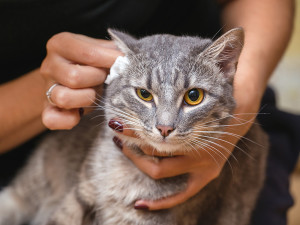5 Common Types of Cancer in Cats, Symptoms, and Treatments
Learn how to spot the early signs to how to treat them.
In This Article:
Common Cancer Types Causes and Risk Factors of Cancer in Cats Symptoms of Cancer in Cats Diagnosing Feline Cancers Cancer Treatment Options Frequently Asked Questions
No one wants to hear that their kitty could have cancer, which may bring up fears about your cat’s suffering, quality of life, and, yes, even death. We know it’s truly the last thing you want to think about, but no matter your cat’s current stage of health, it’s important to stay informed for their (and your!) sake. Let’s chat about some of the most common cancers seen in cats and what to look out for.
Five common cancer types
From lymphoma to skin cancer in cats, below are the five most common cat cancers.
1. Lymphoma
Lymphoma is one of the most frequently diagnosed cancers in cats. Lymphocytes are a type of white blood cell that help defend the body against infections. The bone marrow produces lymphocytes, which circulate throughout the body via the blood stream and lymphatic system. Lymphoma occurs when there is an abnormal increase of lymphocytes in the blood or in an organ and can occur in a variety of body systems.
The most common location for this to take place is the gastrointestinal tract — other common locations include lymph nodes, the kidneys, and the nasal cavity. A preexisting infection with Feline Leukemia Virus (FeLV) or Feline Immunodeficiency Virus (FIV) increases the risk of developing lymphoma.
The symptoms of lymphoma vary depending on the location of the disease and may include anorexia, weight loss, lethargy, GI upset, or breathing changes. A veterinary pathologist can diagnose lymphoma using microscopic evaluation of cells collected from abnormal lymph nodes, abnormal fluid drained from the chest or abdomen, or cells aspirated from other affected tissues.
Chemotherapy is the most common treatment for lymphoma in cats. Your vet may also recommend radiation or surgery, depending on the type and location of the cancer.
2. Squamous cell carcinoma
Squamous cell carcinoma (SCC) is another commonly diagnosed cancer; it is a type of cat skin cancer and is the most common oral cancer in cats. It results from the malignant growth of epithelial cells; these cells are found in the outermost layer of the skin and other organs.
SCC most commonly appears on the nasal planum (the hairless part of the nose), on the tips of the ears, around the eyes, and inside the mouth. Cats with squamous cell carcinoma can develop lumps, non-healing sores, or ulceration in the affected area. White cats and cats who sunbathe excessively have an increased risk of developing SCC. Many times, oral tumors are found during routine dental cleanings, so regular preventative dental care can help with early detection of cat skin cancer. Your cat’s veterinarian can obtain cells from the lesion by aspirate or biopsy to definitively diagnose SCC.
Surgery is often the treatment of choice for squamous cell carcinoma. Although SCC is known to be an aggressive cancer, it is typically slow to progress. The goal of surgery is to remove the tumor entirely. If complete removal isn’t possible, partial removal combined with complementary treatments, such as radiation, cryotherapy, or laser therapy may be helpful.
3. Injection site sarcoma
Feline injection site sarcomas are tumors that develop in the connective tissue at injection sites. While the exact reason these tumors develop is unknown, the present presumption is that inflammation at the injection site causes abnormal cell reproduction and tumor formation.
Vaccines, injections of long-acting antibiotics or steroids, and microchips have been associated with this type of cancer. Tumors can develop anywhere from a couple of months to a decade after the actual injection. Despite this possibility, there’s no need to go all anti-vax for fear of tumor development. The risk is low — far lower than the risk of your cat dying from preventable diseases because they are unvaccinated.
Cats with injection-site sarcomas develop firm masses under the skin. These masses are typically not painful. Injection-site sarcomas are often diagnosed with a biopsy. Advanced imaging like a CT scan or an MRI may be recommended to determine how deep or widespread the tumor is. Injection site sarcomas are typically treated with a combination of surgery, radiation, and chemotherapy.
4. Mammary tumors
Mammary tumors are also commonly diagnosed in cats. While mammary masses can be benign or malignant, most in cats are malignant and will spread to the lymph node or lungs prior to detection.
Symptoms seen with mammary tumors include swelling of the affected mammary gland, ulceration or redness of the skin of the belly, or discharge from the affected nipples. Naturally, female cats are at higher risk of developing mammary tumors than male cats. While there’s no need to start performing monthly breast exams on your feline, new lumps or changes to the appearance of the mammary glands should be checked out. Spaying early in life (before six to 12 months of age) helps significantly decrease the likelihood of mammary tumors.
Fine-needle aspirate or biopsy are frequently used to diagnose mammary cancer. These tumors can be treated with a combination of surgery, chemotherapy, and radiation.
5. Skin cancer
Cats can develop multiple types of skin cancer, and their fur can either highlight or camouflage skin changes. Although not every lump or bump is harmful, you should not ignore skin changes.
A basal cell tumor is a cancer that affects the top layer of skin, hair follicles, and sebaceous glands and is the most common form of skin cancer in cats. Basal cell tumors tend to occur in older cats, with Siamese and Persian being the most common breeds affected. These tumors tend to appear as a single, hairless, pigmented cyst or ulcer, typically on the head or neck. The good news is that basal cell tumors are usually benign and rarely spread to the lymph nodes. Your vet will likely opt for surgical removal. Radiation and/or chemotherapy may be pursued if the tumor is malignant or if complete removal is not possible.
Mast cell tumors are the second most common skin cancer in cats. Mast cells are part of the immune system and release histamine and other substances when triggered. Mast cell tumors are typically firm, raised, and hairless and can show up as one single tumor or as a group. The area surrounding a mast cell tumor can become inflamed, especially if the cat is rubbing or scratching the area (these tend to be itchy). These tumors are usually benign, but can spread to the lymph nodes and other organs. Complete surgical removal is the treatment of choice, but medical management is an option if surgery isn’t.
Cats can also develop melanoma, a cancer of the melanin-producing cells in the skin. Unlike in people, exposure to sunlight doesn’t have anything to do with melanoma development in cats. Cats get melanoma far less often than dogs, but malignant melanoma is more common in cats. Melanoma can develop in the mouth or the eye (this is bad news and aggressive). Melanoma tumors usually occur on the face or head but can pop up on other parts of the body. Once again, the recommended treatment is complete surgical removal. Radiation is recommended when wide surgical margins can’t be achieved.
Causes and risk factors of cancer in cats
Just as in humans, cancer in cats can be caused by a variety of causes, and it’s often difficult to pin down exactly what causes cancer in cats. Risk factors are similar to those of humans; exposure to sunlight, exposure to toxins, a lack of exercise, and genetic components have all been associated with higher cancer risk. Neglecting to spay a cat can also increase their risk for mammary cancer. Feline leukemia virus (FeLV), a common infectious disease in cats, is the most common cause of cancer in cats.
Secondhand smoke is also a major risk factor. According to the FDA,opens in new tab cats who regularly breathe in secondhand smoke are two to four times more likely to develop squamous cell carcinoma and three times more likely to develop lymphoma.
Symptoms of cancer in cats
Signs of cancer in cats vary depending on what kind of cancer a cat has. Symptoms that indicate you want to have your cat seen by a veterinarian to rule out cancer include:
Weight loss
Lethargy
Bad breath
Difficulty urinating
Lumps
Vomiting
Swelling
Behavioral signs of pain
How is feline cancer diagnosed?
First, a vet will perform a biopsy or fine-needle aspiration of the mass to confirm the diagnosis. Next, staging determines if the cancer has spread anywhere else in the body. Radiographs, ultrasound, and lymph node aspirates are common tools for staging.
What are the treatment options for feline cancer?
After diagnosis, your veterinarian will discuss treatment options based on the cancer type, stage, and grade. Treatment options include surgery, chemotherapy, radiation, immunotherapy, and palliative care.
While nobody wants to hear that their feline friend may have the Big C, working together with your family veterinarian or a veterinary oncologist can help you determine the best course of action for you and your kitty.
FAQs (People also ask)
What happens when your veterinarian says your cat might have cancer?
If a veterinarian says your cat might have cancer, they will perform a biopsy or fine-needle aspiration of the mass. If the diagnosis is confirmed, they will explore treatment options, including surgery and chemotherapy, with you.
How long will a cat live with cancer?
A cat’s prognosis depends on the type of cancer and the cancer’s progression. Your veterinarian will be able to estimate your cat’s prognosis.
What are the final stages of cancer in cats?
The final stages of cancer in cats will often include a loss of appetite, a decrease in activity, difficulty urinating, and changes in behavior.











